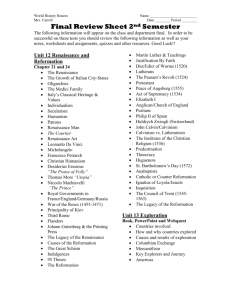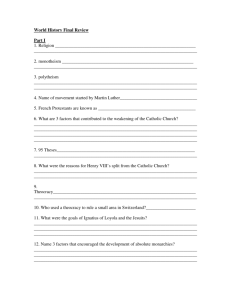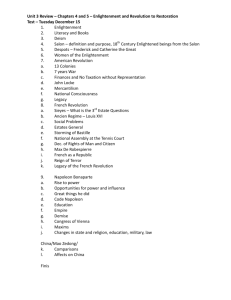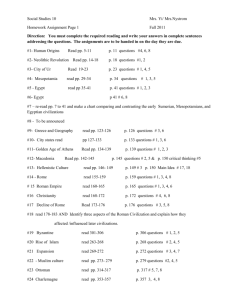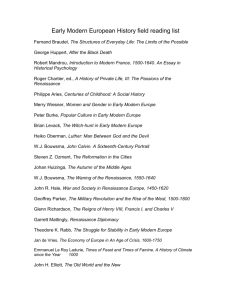World History Study Guide: Reformation and Renaissance
advertisement
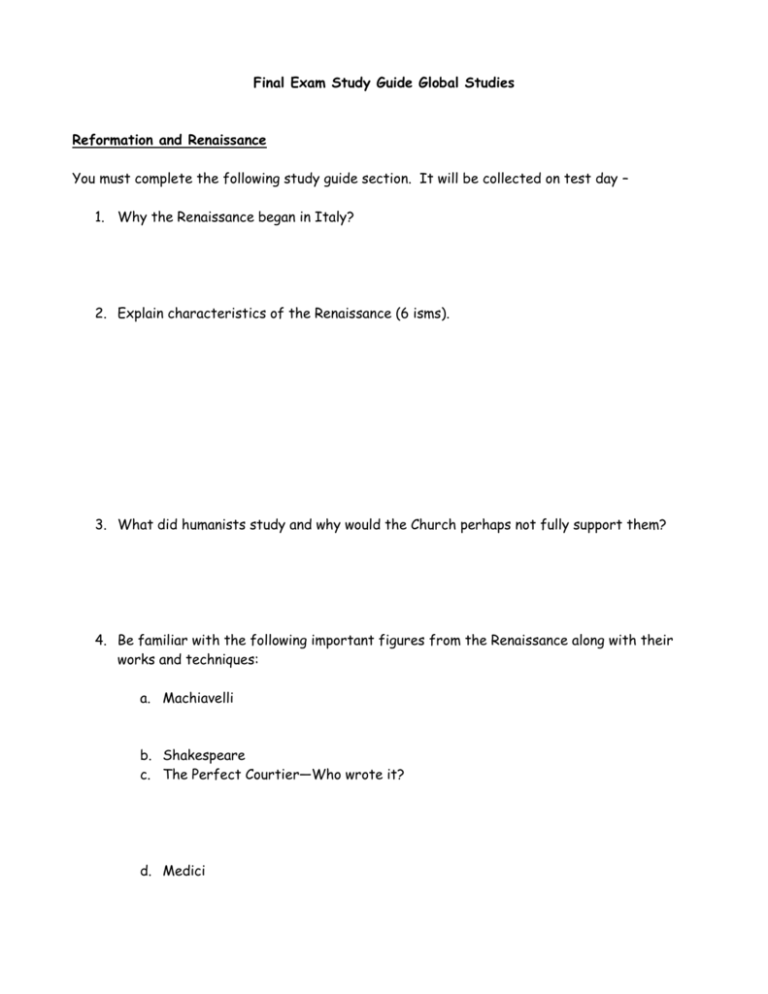
Final Exam Study Guide Global Studies Reformation and Renaissance You must complete the following study guide section. It will be collected on test day – 1. Why the Renaissance began in Italy? 2. Explain characteristics of the Renaissance (6 isms). 3. What did humanists study and why would the Church perhaps not fully support them? 4. Be familiar with the following important figures from the Renaissance along with their works and techniques: a. Machiavelli b. Shakespeare c. The Perfect Courtier—Who wrote it? d. Medici 5. Explain some abuses/control of the Church during the Middle Ages and Renaissance. 6. Who invented the printing press and how did it impact the world? 7. Explain indulgences. 8. Explain the circumstances that led to Luther’s break with the Church. 9. Explain Luther’s main teachings. 10. Explain how politics was at the root of Henry VIII’s break with the RC Church. 11. Identify and explain the significance of the following terms/people related to the Reformation: a. Luther b. Tetzel c. 95 Theses d. Protestant Reformation e. Catholic Reformation f. Henry VIII’s wives Absolutism 1. Divine Right Theory 2. Absolutism—characteristics and examples 3. The goal of mercantilism 4. Louis XIV’s control of the nobles—how did he accomplish this? Provide examples. Scientific Revolution 1. How the 6 Renaissance isms apply to the Scientific Revolution 2. heliocentric vs. geocentric 3. Contributions of a. Copernicus b. Kepler c. Galileo Enlightenment and French Revolution 1. How the Scientific Revolution influenced the Enlightenment 2. The ideas of Hobbes and Locke and how they influenced the Enlightenment. 3. General ideas/beliefs of the Enlightenment by various philosophes 4. Explain the socio-economic classes in France in the 1700s – three estates. 5. How the Enlightenment influenced the French Revolution 6. Various stages of the Revolution and significance of Napoleon. 7. Political spectrum labels as they relate to French Revolution. Draw and label. Industrial Revolution 1. What are the six killer apps? Why are they important? West vs. East? 2. What is the Industrial Revolution? 3. What was life like before the Industrial Revolution? 4. Why Britain? 5. What industry was changed by the industrial revolution? 6. Domestic system vs. factory system 7. What was the Enclosure Movement? 8. What change did the Enclosure Movement cause? 9. Explain the Agricultural Revolution What are the new inventions? Why are they important? 10. Factors of Production a. b. c. 11. What are the 7 M’s? 12. Positives of Industrialization 13. Negatives of Industrialization 14. Capitalism vs. Socialism vs. Communism Define each: Compare and contrast each term: 15. Who is Adam Smith? Why is he significant? o What is his philosophy? 16. Who is Karl Marx? Why is he significant? o What is his philosophy? 17. The Little Red Hen o Who is the story criticizing? 18. Locate Britain, France, Belgium, Germany, Russia and Japan on a map 19. Terms to know: o Entrepreneur o Collective bargaining o Unions o Strike o Industrialization o Corporation o Urbanization Imperialism in Africa Myths and Facts of Africa Berlin Conference Henry Stanley David Livingstone Belgian Congo Leopold II Tactics used by Leopold Resources sought after South Africa Boers/Afrikaners Boer War Zulus Apartheid Cash Crops Egypt Independent Nations within Africa 1. 2. Rwanda history (Hotel Rwanda) Invisible Children Consequences of Imperialism (+ and -) Imperialism II in China, Japan and India Identify and explain the significance of the term/phrase/person. Past General Terms on Imperialism The Four Driving Forces of Imperialism Ways to imperialize (colony, protectorate, sphere of influence) China (Chapter 12.1) Reasons for imperialism in Asia Reasons for Chinese reluctance to trade Mandate of Heaven Isolationism Guangzhou or Canton Opium War (causes and effects) Open Door Policy Extraterritorial rights Boxer Rebellion Treaty of Nanjing Taiping Rebellion or Peasant Revolt Japan (12.2) Closed Door Policy Samurai culture Bushido Millard Fillmore Matthew Perry Treaty of Kanagawa Meiji Era Japanese modernization (social classes, economic, political, education, etc.) Similarities/Differences of Japanese and Chinese policy (Venn Diagram) British Colonial India (11.4) British East India Company Sepoy Mutiny “Jewel in the Crown” Hindu Caste system Muslims vs. Hindus The Story of India (main topics) *Be sure to know who controlled the areas on the map we discussed as well as general info about those places as well.
